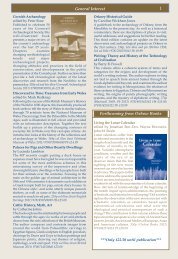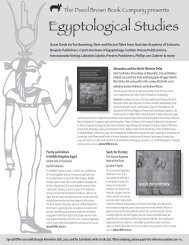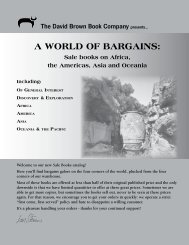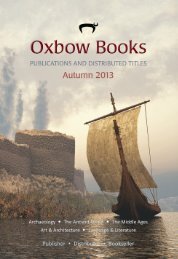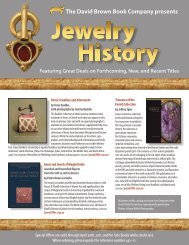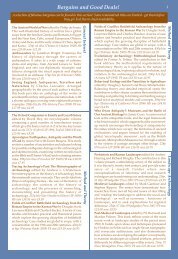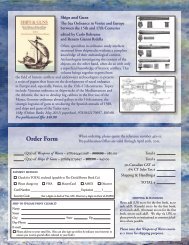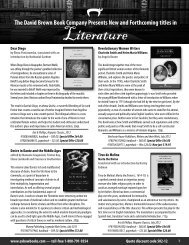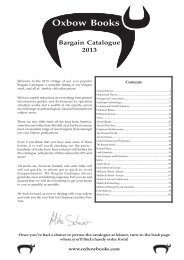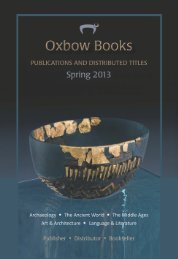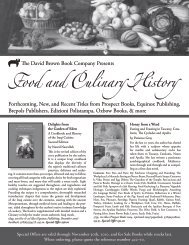New Distributed Titles Fall 2009 - Oxbow Books
New Distributed Titles Fall 2009 - Oxbow Books
New Distributed Titles Fall 2009 - Oxbow Books
You also want an ePaper? Increase the reach of your titles
YUMPU automatically turns print PDFs into web optimized ePapers that Google loves.
The Archaeology of the Dead<br />
by Henri Duday, translated by Anna Maria Cipriani and revised by John Pearce<br />
Henri Duday is Director of Research for CNRS at the University of Bordeaux. The Archaeology of the Dead is based on an intensive specialist<br />
course in burial archaeology given by Duday in Rome in November 2004. The primary aim of the project was to contribute to the<br />
development of common procedures for excavation, data collection and study of Roman cemeteries of the imperial period. Translated<br />
into English by Anna Maria Cipriani and John Pearce, this book looks at the way in which the analysis of skeletons can allow us to<br />
rediscover the lives of people who came before us and inform us of their view of death. Duday thoroughly examines the means at our<br />
disposal to allow the dead to speak, as well as identifying the pitfalls that may deceive us.<br />
230p, b/w illus, paperback, 9781842173565, $60.00, <strong>Oxbow</strong> <strong>Books</strong>, August <strong>2009</strong>, Studies in Funerary Archaeology 3.<br />
<strong>New</strong> in paperback!<br />
The Social Archaeology<br />
of Funerary Remains<br />
edited by Rebecca Gowland<br />
and Christopher Knüsel<br />
Human bones form the most direct link<br />
to understanding how people lived in<br />
the past, who they were and where they<br />
came from. The interpretative value of<br />
human skeletal remains (within their<br />
burial context) in terms of past social<br />
identity and organization is awesome,<br />
but was, for many years, underexploited<br />
by archaeologists. The nineteen papers<br />
in this edited volume are an attempt to<br />
redress this by marrying the cultural aspects of burial with the anthropology<br />
of the deceased.<br />
320p, paperback, 9781842173657, $70.00, <strong>Oxbow</strong> <strong>Books</strong>, June <strong>2009</strong>,<br />
Studies in Funerary Archaeology 1.<br />
Childhood in the Past<br />
Volume 2 (<strong>2009</strong>)<br />
edited by Eileen Murphy<br />
This journal provides a peer-reviewed, interdisciplinary, international forum<br />
for the publication of research into all aspects of children and childhood in the<br />
past, which transcends conventional intellectual, disciplinary, geographical and<br />
chronological boundaries.<br />
Contents include: Natural History in the Periodical Literature of Victorian<br />
Working Class Boys; Children in a Changing Social Landscape: A Case Study<br />
from the American Southwest; Saving Childhood in Everyday Objects; Hearth<br />
and Home: The Burial of Infants within Romano-British Domestic Contexts;<br />
Breastfeeding and weaning behaviour in archaeological populations.<br />
160p, paperback, 9781842173787, $50.00, <strong>Oxbow</strong> <strong>Books</strong>, November <strong>2009</strong>.<br />
world archaeology<br />
Archaeology and Memory<br />
edited by Dušan Borić<br />
This volume seeks to examine how the notion of memory can significantly structure<br />
the research efforts in the empirical field of archaeology. The archaeological approaches<br />
enable the diversity of mnemonic systems and their significance in past contexts to<br />
be explored and to examine what can be put under the heading ‘past in the past’. The<br />
twelve substantial contributions by distinguished contributors cover a diverse set of<br />
regional case studies and focus on a range of prehistoric and classical case studies in<br />
the Eurasian regional contexts as well as on predicaments of memory in examples of<br />
the archaeologies of ‘contemporary past’. Archaeology and Memory shows the importance<br />
of memory as a unifying term for thinking about past contexts and the way in<br />
which people thought about their own pasts, as well as wider theoretical reflections<br />
on materiality and archaeological methodologies.<br />
272p, 78 b/w illus, hardback, 9781842173633, $110.00, <strong>Oxbow</strong> <strong>Books</strong>, December <strong>2009</strong>.<br />
Food and Drink in Archaeology 2<br />
University of Nottingham<br />
Postgraduate Conference 2008<br />
edited by Naomi Sykes<br />
and Claire <strong>New</strong>ton<br />
This is the second volume of a series from the<br />
Department of Archaeology at Nottingham<br />
University. Save for the keynote essay, all the<br />
authors are postgraduate researchers. While the<br />
importance of nutrition for survival has long<br />
been recognized, increasing emphasis is being<br />
put on the cultural significance of the production, distribution and consumption of<br />
foodstuffs throughout all archaeological periods. These papers reflect an interest in<br />
the sorts of foods consumed, the ways in which they were consumed, and the consequences<br />
of their consumption. Contributions range widely over Europe and Asia and<br />
cover several forms of historical or archaeological investigation based on documentary<br />
and visual records as well as excavation and chemical analysis. In like manner, a<br />
number of different historical and prehistorical eras are under discussion.<br />
160p, 36 b/w illus, paperback, 9781903018682, $40.00, Prospect <strong>Books</strong>, December <strong>2009</strong>.<br />
www.dbbconline.com 9




